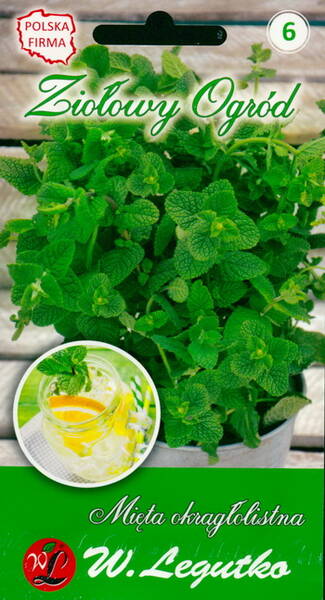Officinal (medicinal) plant.
Natural flowering period: Juli-September.
Winter hardiness zones: Z5-Z8.
Height: 30 cm.
Pink-white, hairy foliage, culinary herb, tea herb.
Apple mint is an extremely unpretentious and well-growing perennial. Stems are firm, straight and about 30-40 cm high.
The leaves are wrinkled and green, with a pleasant specific aroma. The flowers are small and white, collected in dense brushes, located at the tops of the shoots and in the axils of the leaves.
Blooms in late July-August. It can grow in any soil with sufficient light, but it develops better in fertile and well-hydrated soil.
Location: photophilous, but tolerates shading well. In this case, the soil should be less wet.
Soil: grows well in loose fertile soils. However, places with excessive moisture and heavy clay soil are unsuitable for it. It can produce good yields on calcareous soils, but the oil obtained from such plants is not very flavorful.
Care: mint thickets should be renewed every 3-4 years, as they do not resist weeds well and fall out quickly. To protect the mint from freezing, in the fall the ridges are covered with a layer of loose earth, or covered with spruce branches, straw, or a dry leaf. Top dressing of plants is carried out in early spring and in the phase of branching - the beginning of budding.
Care consists in loosening the soil, which protects it from excessive evaporation of moisture, improves the air regime and prevents compaction. Watering - as needed.
Reproduction: segments of rhizomes with a renewal bud, stolons or cuttings in the phase of 3-5 leaves. Landing is carried out in early spring (late April - early May) and in August.
Use: during growth and flowering, it exudes a very pleasant aroma. Thickets of mint look good in the background of flower beds, creating a dense background.
Mint grows especially well on loose sandy soils under sea buckthorn.
It must be remembered that mint is quite aggressive, grows rapidly and can displace other crops from the flower garden. Therefore, it is better to plant it in containers.
Eng.: Applemint, Round-leaved Mint. Bot. syn.: Mentha rotundifolia.
* The first information about the use of apple mint dates back to very distant times: it was mentioned on the cuneiform tablets of the Assyrians, it was found in the tombs of the Egyptian pharaohs.
The name of the plant was given by the ancient Greeks in honor of the nymph Menta, the beloved ruler of the underworld of Pluto. His jealous wife turned the unfortunate woman into a plant with a delicate, cold scent.
* Vegetable garden on the windowsill.
If you like to add herbs when cooking, then you can place pots of basil, rosemary, lemon balm, sage, thyme, etc. on the windowsill in the kitchen to use them in winter. This way you will always have your favorite seasonings at hand.
The kitchen window sill is a great place for plants: the air in the kitchen is often humid, and the plants are always in front of your eyes, so you won’t forget to water them.
Most people are unlikely to want to plant a whole herb garden in their home, but a couple of pots of lettuce and the herbs you use most often won't hurt anyone. Just remember to periodically trim off your favorite herbs, otherwise the leaves will begin to stretch out and the potted plants will become unattractive.
If you don't have experience yet, start small. Fill several pots with planting mixture (the surface level of the compacted soil should be 0.5 cm below the rim of the pot). A standard herb garden kit consists of a pot of mint (dig up a few plants along with roots from the garden), parsley (grown from seeds), chives (dig up a bush in your garden) and spring onions (grown from seeds).
Water the transplanted plants, and once they are established, water them once or twice a week. As for crops, it is important to ensure that the soil is constantly moderately moist before germination.
Cut mint, parsley or chives as needed, and pull onion bulbs out of the ground. Don't forget to spray the plants with water once or twice a week.
Starting with these basics, you can go further over time.
The next step is to grow the lettuce: sow the seeds in a shallow plastic tray.
If you have space for a pot with a diameter of 15 cm, then you can grow miniature tomatoes (for example: "Venus", "Bajaja" and others).












